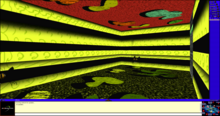This article has multiple issues. Please help improve it or discuss these issues on the talk page. (Learn how and when to remove these messages)
|

Worlds.com, or Worlds Chat is an online chat program launched by Worlds Inc in April 1995. Worlds.com was the first program made available for the general public to download from Worlds Inc's website for free. But download is no longer available.
User interface
Worlds.com is a virtual world platform that offers users a selection of pre-existing 3D avatars to serve as their representation within the virtual environment. The gallery of avatars is presented from a first-person perspective. Upon selecting an avatar, the user is placed within the central hub of a virtual space station, where they can interact with other online users who are also represented by avatars.
Within the virtual space station, users can navigate between platforms through sliding doors and hallways. Each platform is occupied by a group of users with whom the user can interact. The platform interface provides several sections, including software notifications, a 3D interface similar to the video game Doom, a chat message window, and a space station map indicating the user's current location.
Worlds Chat team
Assembled by Dave Marvit (VP of Production), the original team that constructed Worlds Chat consisted of Andrea Gallagher (producer), Dave Leahy, Syed Asif Hassan, and Bo Adler (development), and Jeff "Scamper" Robinson and Helen Cho (UI and graphics). The original client/server protocol for the multi-user environment was developed by Mitra Ardron, Bo Adler, Judy Challinger, and Dave Leahy (PTO US6219045). Contributors to the project included David Tolley (music), Wolf Schmidt (documentation), John Navitsky and Scott Benson (operations), Naggi Asmar (quality assurance), and others.
Technical challenges
The first release of VRML, a standard for defining virtual worlds, was less than six months old when Worlds.com was released, and thus still lacking in any best practices to use. Additionally, the speed of dial-up Internet connections placed limitations on the amount of information that could be transmitted to and from the Worlds Inc. servers. An increasing number of users alongside the expanding virtual world increased these pressures. Unlike other immersive environments of its day, it worked on lines as slow as 9600 baud.
In 2011, Tamiko Thiel, the creative director and producer at Worlds Inc. from 1994 to 1996, wrote an article entitled "Cyber-Animism and Augmented Dreams" describing the history of virtual worlds, in which she wrote: "In the virtual worlds and avatar communities in the mid 1990s, we thought we all would start parallel, virtual, online existences in which we could create ourselves anew and realize our personal dream worlds. The technology however was too awkward, the processors and the Internet connections too slow, and the user base for our worlds never extended beyond a small dedicated community. By 2002, the virtual communities of the first generation all went bankrupt or looked for other ways to earn money."
See also
References
- "ACM interactions, Sept-Oct 1996". Ccon.org. pp. 27–34. ISSN 1072-5520.
- "Worlds Inc: Worlds Chat, industrial demo of first Internet-based avatar world (May 1995)". Archive.org. 26 April 1995. Retrieved 26 April 2022.
- "Scalable virtual world chat client-server system". Patents.google.com. Retrieved 26 April 2022.
- Tamiko Thiel (4 June 2011). "CYBER-ANIMISM AND AUGMENTED DREAMS. THE URGE TO AUGMENT" (PDF). Leoalmanac.org. Retrieved 26 April 2022.